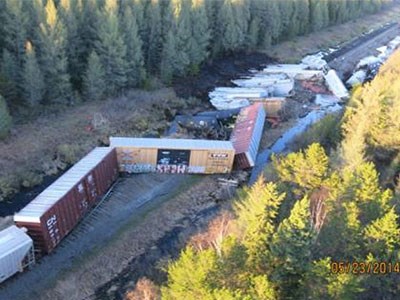Canadian National Railway (CN) is being called out by federal investigators for poor track maintenance that resulted in the derailment of a freight train in northwestern Ontario in May 2014.
The Transportation Safety Board of Canada (TSB) released its findings on the derailment on March 16.
The agency blamed poor track condition and maintenance deficiencies on CN’s part that resulted in 35 freight cars leaving the track at Mile 93.38, just outside Fort Frances.
The string of cars included two tank cars containing molten sulfur, one of which was punctured, released product and started a small grass fire which burned itself out.
Five hundred feet of track was destroyed. There were no injuries among the crew.
The train was approaching the town on a descending grade when the crew noticed a track misalignment and applied full brakes, causing a section of track to buckle.
Investigators determined the track was in poor condition with defective ties, fouled ballast, and ineffective rail anchoring.
The crew’s braking application added additional compressive forces into an already weakened track structure.
TSB Investigators remarked there was a significant increase in volume and tonnage on this route which had accelerated track deterioration and CN’s maintenance programs were delayed.
At the site of the derailment, freight trains were speeding at 50 miles per hour (mph) on track that only met the standards for 25 mph operation.
The investigation identified that CN did not consistently apply its engineering track standards and Transport Canada’s inspection and enforcement activities did not ensure timely maintenance action.
Following the derailment, Transport Canada issued an order to CN to reduce speed and increase track inspections between Mile 90.1 and 1142.8 of the Fort Frances subdivision.
The order was revoked once Transport Canada was satisfied with the corrective measures taken by CN in installing new ties between Mile 87.0 and 143.6.
CN believes the TSB findings serve as a teaching moment.
“CN seeks to learn from every accident and to continuously strengthen its Safety Management System in order to reduce main track derailments to an absolute minimum,” said spokesman Mark Hallman in a statement.
After a “lengthy review” with Transport Canada, the rail carrier said it concurs with the investigators’ findings and acknowledges it “should ideally have implemented the significant track infrastructure improvements it had planned for the Fort Frances Subdivision more quickly.”
CN said it will redoubled its efforts to strengthen its safety management system and “address the areas of improvement identified” by the TSB.
CN partly attributes the deteriorated state of that section of track to spring ground conditions following a tough winter.
The railroad has $1.5 billion earmarked for track infrastructure this year to replace rails, ties, make bridge improvements and upgrade certain branch lines.




